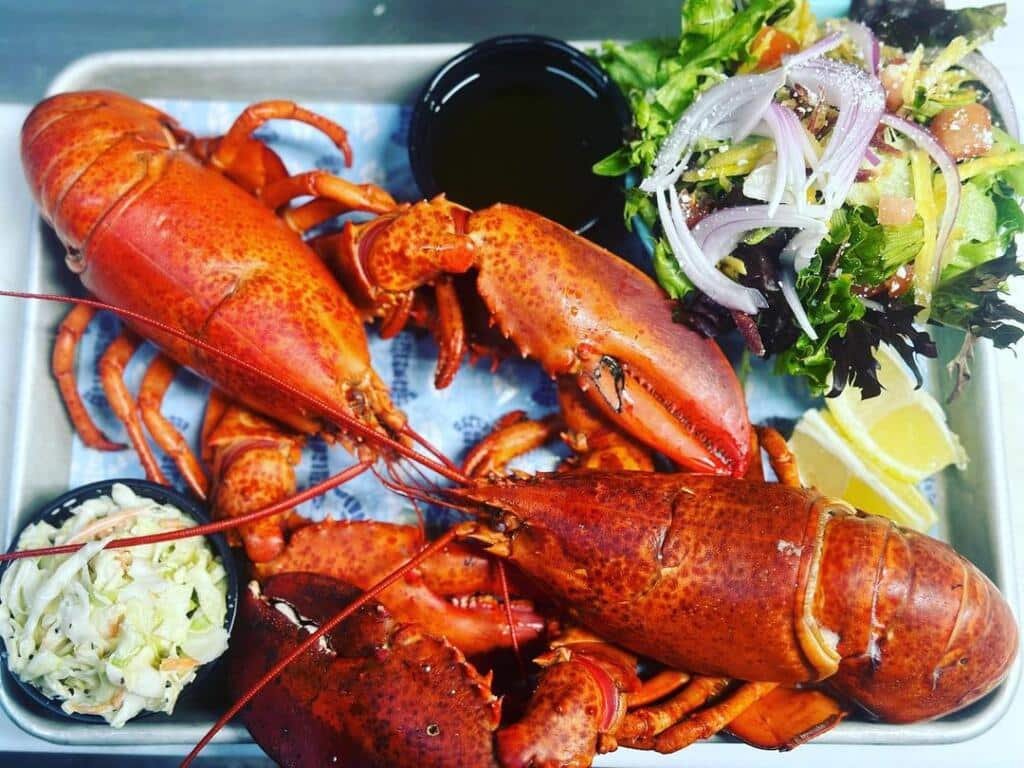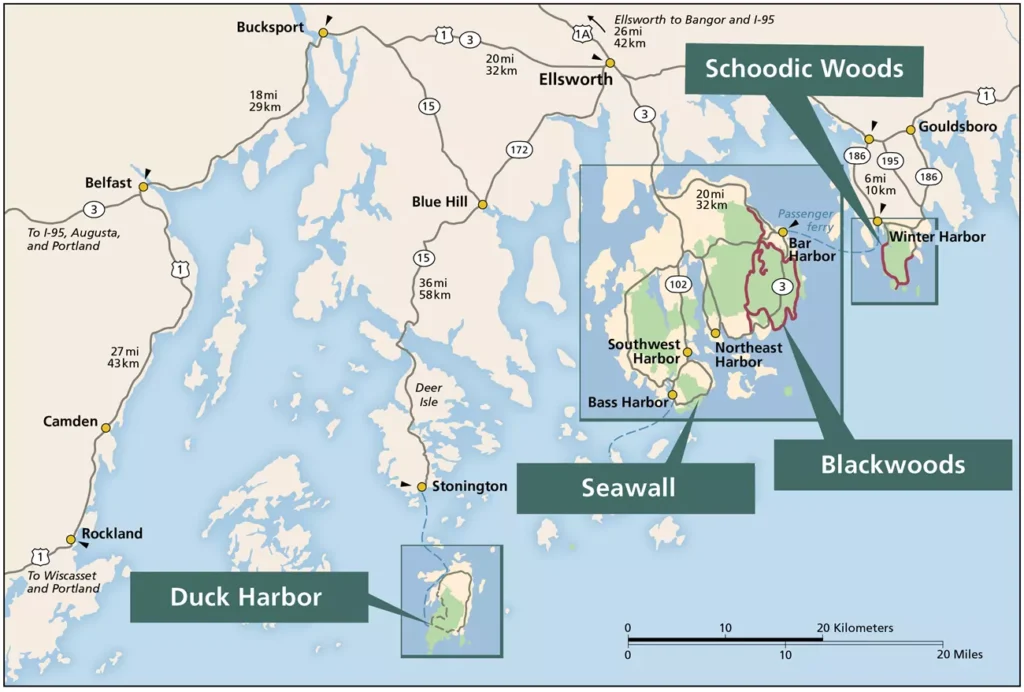Your cart is currently empty!

Hiking & Camping
Explore Acadia’s Hiking Trails

Popular Hiking Trails in Acadia National Park:
- Cadillac Mountain North Ridge Trail
- Difficulty: Moderate
- Length: 4.4 miles round trip
- Features: This trail takes you to the summit of Cadillac Mountain, the highest peak on the U.S. Atlantic coast. The trail offers stunning panoramic views of the surrounding islands and coastline.
- Jordan Pond Path
- Difficulty: Easy
- Length: 3.3 miles loop
- Features: A flat, scenic trail that loops around Jordan Pond, providing beautiful views of the Bubbles (North and South Bubble mountains) and the crystal-clear pond itself.
- Precipice Trail
- Difficulty: Strenuous
- Length: 2.5 miles round trip
- Features: This challenging trail is known for its iron rungs, ladders, and steep cliffs. It is not recommended for those with a fear of heights, but it offers incredible views for those who make the climb.
- Beehive Trail
- Difficulty: Strenuous
- Length: 1.4 miles loop
- Features: Similar to the Precipice Trail, the Beehive Trail is shorter but also includes iron rungs and exposed cliffs. The reward is breathtaking views of Sand Beach and the surrounding area.
- Ocean Path
- Difficulty: Easy
- Length: 4.5 miles round trip
- Features: This trail runs along the coastline from Sand Beach to Otter Point, offering beautiful ocean views and access to iconic spots like Thunder Hole and Otter Cliffs.
- South Bubble Trail
- Difficulty: Moderate
- Length: 1.5 miles round trip
- Features: A short but steep hike that leads to the South Bubble, a rounded peak with impressive views of Jordan Pond and the surrounding area. Don’t miss the famous “Bubble Rock,” a large glacial erratic perched on the edge.
- Gorham Mountain Trail
- Difficulty: Moderate
- Length: 3.5 miles round trip
- Features: A popular trail offering views of the ocean and the surrounding mountains. The trail can be combined with the Beehive Trail for a more challenging loop.
Official Website for Acadia National Park:
You can find more information, including detailed trail maps, park alerts, and visitor guides, on the official National Park Service website for Acadia National Park:
Acadia National Park – NPS Official Website
This site is an excellent resource for planning your visit, understanding the park’s regulations, and getting real-time updates on weather, trail conditions, and more.
Camping Guide
Camping in Acadia National Park offers a great way to fully immerse yourself in the natural beauty of the area. Below are some of the popular campgrounds, along with their locations and recommendations on the necessary gear.

Popular Campgrounds in Acadia National Park:
- Blackwoods Campground
- Location: Located along the southeastern shore of Mount Desert Island, about 5 miles south of Bar Harbor.
- Features: This is the most popular campground, open year-round. It’s close to many of the park’s major attractions, including Cadillac Mountain.
- Reservations: Required during peak season (May to October).
- Facilities: Flush toilets, potable water, fire rings, and picnic tables. No showers, but they are available nearby.
- Seawall Campground
- Location: Situated on the western side of Mount Desert Island, near the town of Southwest Harbor.
- Features: Seawall is a more relaxed and quieter option compared to Blackwoods, with easy access to the less crowded parts of the park.
- Reservations: Required during peak season.
- Facilities: Flush toilets, potable water, fire rings, picnic tables, and an amphitheater. No showers, but they are available nearby.
- Schoodic Woods Campground
- Location: Located on the Schoodic Peninsula, this is the only campground on the mainland portion of Acadia.
- Features: Offers a more secluded experience with easy access to the Schoodic Loop Road and the rugged coastline.
- Reservations: Required.
- Facilities: Flush toilets, potable water, fire rings, picnic tables, and a dump station.
- Duck Harbor Campground
- Location: Located on Isle au Haut, a remote island accessible only by boat.
- Features: This campground is very primitive and offers a backcountry experience with just five campsites.
- Reservations: Required, and highly recommended as spots are limited.
- Facilities: Composting toilets and hand-pumped water. No showers or running water.
Essential Camping Gear for Acadia National Park:
- Tent: A durable, waterproof tent that can handle various weather conditions. Bring a ground tarp or footprint for added protection.
- Sleeping Bag: A warm sleeping bag suitable for cool nights, especially in the spring and fall when temperatures can drop significantly.
- Sleeping Pad: Provides insulation from the ground and adds comfort.
- Camp Stove/Cooking Equipment: Lightweight stove or portable grill for cooking, along with fuel. Firewood is available at some campgrounds, but bringing a portable stove is advisable.
- Food Storage: Use bear-proof containers or store food in your vehicle. Black bears are present in the park.
- Water: While potable water is available at most campgrounds, it’s a good idea to bring your own supply or a water filtration system for backcountry camping.
- Lighting: Headlamps or lanterns for navigating at night.
- Clothing: Layered clothing to adapt to changing weather, rain gear, and sturdy hiking boots.
- First Aid Kit: Essential for any emergencies.
- Map/Compass or GPS: Essential for navigating trails.
- Backpack: For carrying essentials during hikes.
Additional Tips:
- Reservations: Make sure to book your campsite well in advance, especially during peak season, as sites fill up quickly.
- Leave No Trace: Always follow Leave No Trace principles, especially in remote areas like Duck Harbor.
- Weather: Be prepared for variable weather, including rain and cold nights, even in summer.
For more information on reservations and campground specifics, visit the Acadia National Park Camping Page on the National Park Service website.